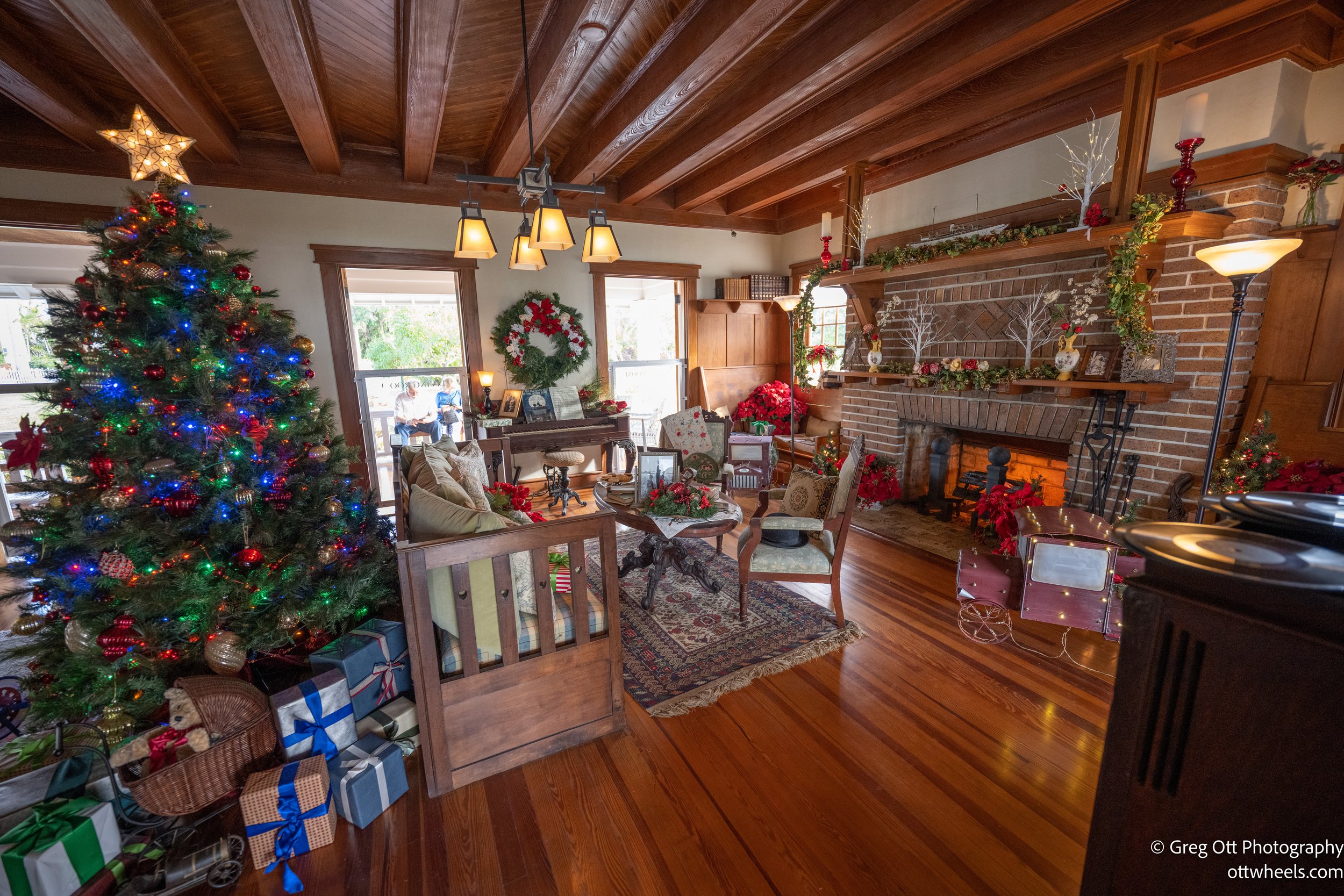Edison / Ford Houses
I decided to tour the Edison and Ford Winter Estates, also known as the Edison House, in Fort Myers, Florida. It was the winter home of American inventor Thomas Edison and his friend, Henry Ford, who were both drawn to the area for its warm climate and natural beauty. The website indicated there was a downloadable app providing a self guided tour. I was skeptical, and was pleasantly surprised.
There is ample parking and I found a spot near the entrance. I had bought my ticket online but was told I needed to go to the ticket center to obtain a wristband. Near the visitors center, a massive Banyan tree greets visitors. The tree cover’s almost one acre.
Although the homes were interesting for various reasons, I was interested more in the museum and Edison’s research laboratory. There have been many debates over the years on whether Edison was an inventor or a viable product developer. From my management of technology (MOT) classes at Maryland we discussed how products evolve from idea, to viable product and are followed by countless improvements. Edison’s name came up various times during that course work. The lightbulb is just one of many proven ideas where Edison further developed into a viable product.
Edison House
The Edison House preserved to reflect the style and design of the time period in which Edison and Ford lived. The estate features a mix of architectural styles, including Queen Anne and Mediterranean Revival. Edison's home, known as Seminole Lodge, is a large, two-story mansion that was built in 1886. The house is decorated in a tropical style, with many original furnishings and artifacts from Edison's life.
The house includes a number of Edison's inventions, including a phonograph, early light bulbs, and electraliers. The “electralier” was an electric chandelier designed and developed by Thomas Edison in the late 19th century. The Electralier was one of the first electric light fixtures designed for use in homes and other indoor spaces, and it was intended to replace traditional gas-powered chandeliers.


There were many notable guests that visited Edison and Ford at their homes. No doubt these visits would lead to new products and business developments. A short guest includes the following:
President Calvin Coolidge: Coolidge and his wife visited the estate in 1928 and were welcomed by Edison and Ford.
Harvey Firestone: Firestone, the founder of the Firestone Tire and Rubber Company, was a close friend of Edison and Ford, and he visited the estate on several occasions.
Charles Lindbergh: Lindbergh, the famous aviator, visited the estate in 1927 and met with Edison and Ford.
Harvey S. Firestone Jr.: Firestone Jr., the son of Harvey Firestone, also visited the estate and was a guest of Edison and Ford.
John D. Rockefeller: Rockefeller, the founder of Standard Oil, visited the estate in 1916 and spent time with Edison and Ford.
I was fascinated with the pier that juts out into the Caloosahatchee river behind the Edison home. The pier was originally built to allow boats to unload building materials, furnishings, and eventually research equipment. The Edison family enjoyed finish off the pier with guests. The pier evolved over time to include a structure for entertainment on the river. Much of the original pier is gone, but a new project is in the works to bring the pier back to its glory days.
Ford House
The Ford House is a two-story, Mediterranean-style mansion that was built in 1916 and is located beside the Edison home. The house was designed by architect Albert Kahn and features a red tile roof, white stucco exterior, and a large courtyard. I was struck by the simplicity of these homes.
Arts and craft design was popular during this period and elements of this style can be seen throughout the home. The Style emphasized the use of oak work, craftsmanship and attention to detail. The home was decorated with high-quality, handmade furnishings and decorative elements that reflected the arts and crafts aesthetic. I was surprised that there was no stained glass windows in the home.



Inside the house, a number of original furnishings and artifacts from Ford's life can be seen, including a collection of Ford automobiles (missing due to renovation during my visit) and other memorabilia from his career. The house also includes a museum dedicated to Ford's life and work, which features exhibits on the history of the Ford Motor Company and the innovations that Ford contributed to the automotive industry.
Botanical Gardens
The estate's botanical gardens feature over 1,700 varieties of plants, including exotic species that were brought back by Edison and Ford from their travels around the world. In addition to the botanical gardens, the Edison House is also home to a research laboratory where Edison conducted experiments and developed new technologies. One area of research that was particularly important to Edison was the development of rubber.
Edison was interested in finding a way to produce a more durable and reliable source of rubber, which was a critical material for a number of industrial and consumer products. He conducted extensive research on the subject and developed a number of processes and technologies that were intended to improve the production of rubber.



Museum
In addition to the homes, there is a museum on site that covers the work of both Edison and Ford. Ford initially worked for Edison and later left to develop the internal combustion engine and eventually the Ford Motor Company.
Thomas Edison is known for his numerous inventions, which have had a significant impact on society and have helped shape modern technology. Some of his most famous inventions include:
The light bulb: Edison is perhaps best known for his development of the first commercially practical incandescent light bulb.
The phonograph: Edison's phonograph was the first device to record and play back sound.
The motion picture camera: Edison's motion picture camera, the Kinetograph, was used to make some of the first motion pictures ever produced.
The alkaline storage battery: Edison's alkaline storage battery was a long-lasting and reliable source of power, and it was widely used in early electric vehicles. There was a battle at the time between electric and gas powered vehicles at the time.
The telegraph: Edison's telegraph system improved upon the existing technology and helped make long-distance communication faster and more efficient.
The mimeograph: The mimeograph, also known as the "Edisonian," was a printing press that used stencils to reproduce documents quickly and inexpensively.
Edison was granted over 1,000 patents for his inventions.
Although he is viewed as a brilliant inventor and one of the most important figures in the history of technology, it may be more appropriate to describe him as a business man that could convert ideas into viable products. While it is true that Edison made numerous significant contributions to the field of invention and helped to develop a number of important technologies, it is also true that he was not solely responsible for the development of his inventions.
Edison's approach to innovation was somewhat different from that of many other inventors. Rather than focusing solely on the process of invention, he was also interested in developing and commercializing his inventions, turning them into viable products that could be manufactured and sold on a large scale. He also relied on the skills and knowledge of his team to turn those ideas into practical and marketable products. This is explored throughout the museum displays.
To this end, Edison built a large research laboratory in Menlo Park, New Jersey, where he and his team of assistants worked (brilliant in their own right) on a wide range of projects. Edison was known for his ability to assemble and lead a team of talented engineers and technicians, and he relied heavily on their expertise and assistance in developing his inventions.
Millenial Brewing
After a long day of cruising the Edison estate, I decided to relax at Millenial Brewing. There was a food truck out front and I ordered tacos. I hung out and worked on emails and tried a couple of their beers. The beer was tasty. They weren’t very crowded. I stayed and watch some sports reruns and then found my way to a Cracker Barrel nearby.






